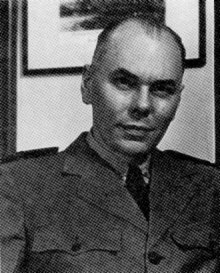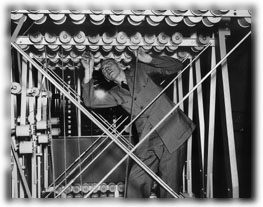Howard Aiken
1900-1973
Born in Hoboken, New Jersey in 1900 and raised in Indianapolis, Indiana, Howard Aiken was awarded a B.A. of Science from the University of Wisconsin in 1923. After several years as a member of the faculty at the University of Miami, he left in 1935 to pursue graduate studies at Harvard. By 1937 he had received a M.A. in physics from Harvard, with a Ph.D. to follow in 1939. Aiken's graduate work on improving the vacuum tube design involved systems of differential equations for which there were no exact solutions so that their only solution involved extremely labor intensive numerical techniques. In fact, to avoid the nearly endless and tedious calculations, Aiken developed a proposal for a machine that would eventually become known as the Harvard Mark I. Some accounts link Aiken's vision to Babbage and the portion of the Babbage machine in the attic of the Harvard physics lab. Other accounts trace his inspiration to Hollerith. Whatever the source, Aiken's project was eventually funded by IBM for the then significant sum of $200,000.
Aik en's
proposal listed four main differences between the machine he envisioned and
mechanical calculators like Hollerith's: (1)The machine must be capable of
handling negative numbers, (2) it must be able to compute functions like sine,
cosine, logarithms, etc.., (3) it was capable of computing functions for
numerous values without user intervention, (4) it computed in lines as opposed
to columns. Ironically, Aiken's machine that would help in his
development of vacuum tubes would rely upon electromechanical power. Aiken
made this choice as a design choice which allowed him to build his machine more
quickly and cheaply than other alternatives. Thus, Aiken's machine would
be a fully automated electro-mechanical hybrid controlled by instruction
sequences. Even w
en's
proposal listed four main differences between the machine he envisioned and
mechanical calculators like Hollerith's: (1)The machine must be capable of
handling negative numbers, (2) it must be able to compute functions like sine,
cosine, logarithms, etc.., (3) it was capable of computing functions for
numerous values without user intervention, (4) it computed in lines as opposed
to columns. Ironically, Aiken's machine that would help in his
development of vacuum tubes would rely upon electromechanical power. Aiken
made this choice as a design choice which allowed him to build his machine more
quickly and cheaply than other alternatives. Thus, Aiken's machine would
be a fully automated electro-mechanical hybrid controlled by instruction
sequences. Even w ith
such compromises, Aiken's machine was not completed for seven years. The
Mark I, offically named the IBM Automatic Sequence Controlled Calculator,
weighed 5 tons, was two feet deep and fifty-one feet long with approximately
750,000 parts. Amazingly, it ran 24 hours a day, seven days a week for 15
years without errors.
ith
such compromises, Aiken's machine was not completed for seven years. The
Mark I, offically named the IBM Automatic Sequence Controlled Calculator,
weighed 5 tons, was two feet deep and fifty-one feet long with approximately
750,000 parts. Amazingly, it ran 24 hours a day, seven days a week for 15
years without errors.
Aiken founded the first computer science program at Harvard
and taught there until he retired in 1961. He retired to Florida, and died
March 14, 1973 in St. Louis, Missouri.
Links
| Harvard
Gazette Article
|
Mac
Tutor Biography
|
| Bebop Bytes Back Article | Arsenal High Page (Aiken's high school) |